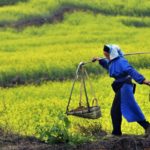 Research from Penn State and the University of Wisconsin-Madison found that having more women involved in agriculture is linked to better community well-being. This is the first study to crunch the numbers on this connection, and the results show that women farmers tend to run their operations in ways that benefit their communities.
Research from Penn State and the University of Wisconsin-Madison found that having more women involved in agriculture is linked to better community well-being. This is the first study to crunch the numbers on this connection, and the results show that women farmers tend to run their operations in ways that benefit their communities.
The findings indicate that in U.S. counties where a greater percentage of farms are owned or operated by women, there are higher rates of nonfarm entrepreneurship, longer life expectancies, and lower poverty rates. Essentially, having more women in the agricultural scene seems to have positive ripple effects on the overall health and prosperity of communities.
Supporting communities
“We know from previous qualitative research that women farmers tend to enter into farming for different reasons than men and often make decisions with the greater good in mind,” the researchers explain.
“For example, they strive to meet a social need in their community or they prioritize environmental stewardship over profits. Our study is the first to use quantitative research methods to explore whether this concept of ‘civic agriculture’ actually translates to improved community well-being in places with higher shares of women farmers.”
The researchers dug into the most recent U.S. Census and the Census of Agriculture, using data at the county level. They ran a bunch of analyses to figure out how women farmers specifically impact three key local economic factors: the poverty rate, average life expectancy, and the rate at which new businesses pop up.
These measures were picked because they give a good sense of a community’s overall quality of life. For instance, the rate of new business formation reflects how much entrepreneurial activity is happening, serving as a solid indicator of economic well-being in a community.
Greater resilience
“Communities with more people starting businesses tend to be more dynamic and resilient to shocks, thus enhancing community well-being,” the researchers explain. “Similarly, a county with less poverty, and where people tend to have longer lifespans, is likely to be a better place to live than a county with higher poverty rates and shorter lifespans.”
The researchers made sure to consider other factors in the community that might be influencing their findings. They checked for things like the racial makeup, the number of single-parent households, and the count of college graduates to rule out any potential impact from these variables.
What’s interesting is that the positive connection with women farmers wasn’t limited to just one county. It spilled over into the neighboring counties as well. In simpler terms, having more women involved in farming in one county was linked to better community well-being not just there but also in the surrounding areas.
“The fact that these spillovers exist suggests having a critical mass of female farmers within a larger region, and not just within a county, has an even greater impact on regional well-being,” the researchers conclude.